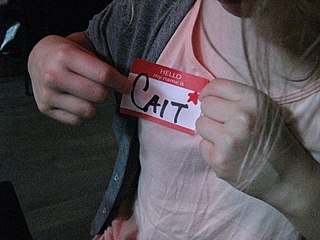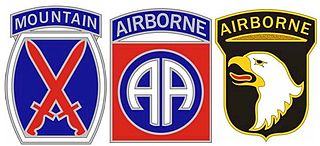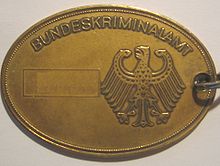Patch collecting or badge collecting is the hobby of collecting patches or badges.

A livery is an identifying design, such as a uniform, ornament, symbol or insignia that designates ownership or affiliation, often found on an individual or vehicle. Livery often includes elements of the heraldry relating to the individual or corporate body featured in the livery. Alternatively, some kind of a personal emblem or badge, or a distinctive colour, is featured.

A slouch hat is a wide-brimmed felt or cloth hat most commonly worn as part of a military uniform, often, although not always, with a chinstrap. It has been worn by military personnel from many different nations including Australia, Ireland, the United Kingdom, Canada, India, New Zealand, Southern Rhodesia, France, the United States, the Confederate States, Germany and many others. Australia and New Zealand have had various models of slouch hat as standard issue headwear since the late Victorian period.

A lanyard is a length of cord, webbing, or strap that may serve any of various functions, which include a means of attachment, restraint, retrieval, activation, and deactivation. A lanyard is also a piece of rigging used to secure or lower objects aboard a ship.

The Army Staff Identification Badge is an identification badge awarded by the Chief of Staff of the Army to Officers and sergeants major assigned to authorized positions at Headquarters, Department of the Army.

A cap badge, also known as head badge or hat badge, is a badge worn on uniform headgear and distinguishes the wearer's nationality and/or organisation. The wearing of cap badges is a convention commonly found among military and police forces, as well as uniformed civilian groups such as the Boy Scouts, civil defence organisations, ambulance services, customs services, fire services etc.

Mess dress uniform is the most formal type of evening-wear uniform used by military personnel, police personnel, and other uniformed services members. It frequently consists of a mess jacket, trousers, white dress shirt and a black bow tie, along with orders and medals insignia. Design may depend on regiment or service branch, e.g. army, navy, air force, marines, etc. In modern Western dress codes, mess dress uniform is the supplementary alternative equivalent to the civilian black tie for evening wear. Mess dress uniforms are typically less formal than full dress uniform, but more formal than service dress uniform.

The Air Force Security Forces Shield is a military badge of the United States Air Force Security Forces. Originally known as the "Air Police Shield" and the "Security Police Shield," the Air Force Security Forces Shield has existed since the early 1960s. The shield is worn in the center of the left breast pocket of all Air Force uniforms, or in an approximately equivalent location if the uniform does not have breast pockets. For females in dress uniforms, the shield is worn above the name tag on the wearer’s right side. The shield is usually not worn on the OCP uniform, being substituted by the "SF" brassard patch on the wearer's left arm. The Security Forces Shield placed in the same location, in a subdued tone with or without an OCP background is an acceptable alternative as well. The Security Forces shield is the primary identification for officers and enlisted members of the Air Force Security Forces.

Identification badges of the uniformed services of the United States are insignia worn by service members conducting special duties, many of which can be awarded as permanent decorations if those duties are performed successfully. There are a few identification badges that are awarded to all services, others are specific to a uniform service. The Office of the President and Vice President and department/service headquarters badges are permanent decorations for those who successfully serve in those assignments. Some of the service level identification badges can be permanent decorations and others are only worn by a service member while performing specific duties, such as the Military Police Badge.

Badges of the United States Army are military decorations issued by the United States Department of the Army to soldiers who achieve a variety of qualifications and accomplishments while serving on active and reserve duty in the United States Army.
A rosette is a small, circular device that is typically presented with a medal. The rosettes are either worn on the medal to denote a higher rank, or for situations where wearing the medal is deemed inappropriate, such as on a suit. Rosettes are issued to those awarded a knighthood or damehood in a chivalric order, as well as state orders in nations such as Belgium, France, Italy and Japan, among others. Certain hereditary societies, such as the Society of Descendants of the Latin Kingdom of Jerusalem, as well as some fraternal orders issue rosettes to their members as well.

An aiguillette, also spelled aguillette, aiglet or aglet, is a cord with metal tips or lace tags, or the decorative tip itself.

A livery collar or chain of office is a collar or heavy chain, usually of gold, worn as insignia of office or a mark of fealty or other association in Europe from the Middle Ages onwards.

The custodian helmet is a type of helmet worn predominantly by male police officers in the United Kingdom and within certain other places around the world. First used by the Metropolitan Police in London in 1863, the BBC labelled the custodian helmet a "symbol of British law enforcement". They are worn by male constables and sergeants on foot patrol. A cultural icon, it has featured in films, TV series and other media involving British police.

A lapel pin, also known as an enamel pin, is a small pin worn on clothing, often on the lapel of a jacket, attached to a bag, or displayed on a piece of fabric. Lapel pins can be ornamental or can indicate the wearer's affiliation with a cause or an organization, such as a fraternal order or religious order; in the case of a chivalric order, the lapel pin is in the form of a rosette. Before the popularity of wearing lapel pins, boutonnières were worn.

A name tag is a badge or sticker worn on the outermost clothing as a means of displaying the wearer's name for others to view.

An embroidered patch, also known as a cloth badge, is a piece of embroidery which is created by using a fabric backing and thread. The art of making embroidered patches is an old tradition and was done by hand. During the first half of the twentieth century they were commonly embroidered using a shiffli embroidery machine. High-speed, computerized machines have led to mass production.

The Singapore Police Force has employed several different styles of uniforms throughout its history. Since 1969 it has used dark blue for its uniforms, although the first police uniforms introduced in 1856 were also in the same colour.

The Combat Service Identification Badge (CSIB) is a metallic heraldic device worn on the right side of the United States Army's Army Service Uniform that uniquely identifies a soldier's combat service with major U.S. Army formations.
Police uniforms in the United States vary widely due to the nation's tradition of highly decentralized law enforcement. Over time, however, a number of general conventions and styles have become representative of American police fashion. Police officers wear uniforms to deter crime by establishing a visible presence while on patrol, to make themselves easily identifiable to non-police officers or to their colleagues who require assistance, and to quickly identify each other at crime scenes for ease of coordination.


























